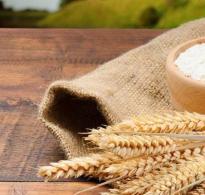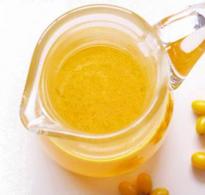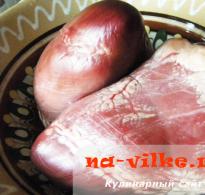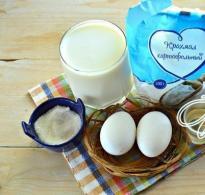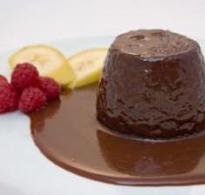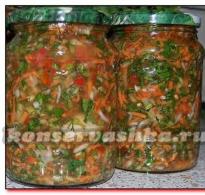What grains are semolina made from? What is semolina made from?
Hello, my dear hostesses, caring mothers who take care of their figure and the health of their family, I welcome you to ours! Today we will talk about semolina, which is the subject of controversy among pediatricians, who either insist on introducing it into the diet of children, or claim that it is a completely useless product.
Even 20 years ago, semolina was recommended for introduction into the diet of children from 3-4 months. Every day in kindergarten started with semolina porridge. Later, pediatricians began to dissuade people from periodically consuming it, arguing that there was nothing useful in it. Before agreeing with this or that opinion, it would be nice to understand what kind of grain semolina is made from.
Where does the cereal for making semolina grow?
Semolina is our “native” product. It is made from wheat grains, just like flour for buns, only more coarsely ground. Small and large semolina are often found on the shelves, which is not surprising: according to the documents regulating production, the acceptable size of grains is from ¼ to ¾ mm.
How is it that the grain crop we are in different types We consume daily, maybe it’s useless? The learned men have learned something! Moreover, for example, they are recommended for use due to their high benefits.
Wheat is a plant that grows in Europe, Asia, and Africa. Not everyone is familiar with semolina; it is more popular in European countries and former Soviet republics. GOST 7022-97, signed by twelve of them, eloquently speaks about this. There are many common standards in the vast post-Soviet space. We can say with confidence that in Kazakhstan, Uzbekistan and Ukraine, semolina is of the same quality as on the shelves of Russian stores.
Cereals made from wheat grains are traditional for all cuisines of the world. There is no continent where this cereal crop is not grown.
Labeling – should you pay attention to it?
When choosing pasta, we are already accustomed to paying attention to the letters that meet international standards for the hardness of wheat varieties. It turns out that the semolina also has corresponding signs, but since the current GOST is ours, Russian, the letters are ours, not Latin.
- The letter “T” indicates that the product is made from durum wheat.
- “M” stands for soft varieties.
- “TM” - grains of different hardness varieties were used for processing.
But it doesn’t matter what label is on the bag, nutritional value This does not change the grain, the caloric content remains the same - 330 kcal per 100 grams of product. There is only 2 percent fiber in semolina.
“Poltavka” and “Artek”, made from the same grain, differ not only in the size of the grains, but also in the fiber content, which is 4 times greater.
Without paying attention to the size of the grains and the labeling of the cereal, I somehow noticed that the taste was somewhat different. If the cereal is made from durum varieties wheat, then it is more structured, not liquid, it feels like it was mixed with other grains to add rigidity. Tastier.
But it should not be used during the recovery period after operations, when it is prescribed dietary broths and other gentle products.
Wheat world cereals
- Bulgur - it is obtained from scalded, dried, flattened grains with boiling water.
- Couscous – crushing grain without pre-treatment boiling water
- Ptitim - produced for the preparation of soups and salads, which involves preliminary boiling.
- Freekeh (farik) - is very rarely used in muesli, but it would be better than others for consumption without boiling. It is made from wheat of milk maturity, when the ear has already turned yellow and the grain has not yet hardened. Collected into sheaves, the ears are dried in the sun. Next comes the miracle of heat treatment with open fire. During the process, the straw should burn along with the shells of the grains, which remain undamaged. This is how cereals are produced in Palestine, Egypt, and North Africa.
- Semolina in Russia is produced using mills, after preliminary drying and threshing. The rest of the wheat cereals are crushed rather than ground, which allows them to retain more fiber.
The right diet or not?

Smart girls, beauties, why torture yourself with the “crackers” that advertisements push? If you look at the calorie content, a serving of semolina porridge is ten times lighter, and it is also warm. If you add slices to it fresh apple, pears, a teaspoon of chopped nuts - the balance of substances necessary for the body is ensured. And supplements of minerals and vitamins for semolina are necessary. It itself is rich only in starch and vegetable protein, which helps cleanse the intestines of mucus and fat. You can also carry out .
Warm food is digested better - a good alternative to cold dairy and kefir cocktails with fruit. They certainly give good effect for proper functioning of the stomach, but it is necessary hot food, otherwise part of the consumed kJ will be spent on warming and processing what was eaten.
For those who like to eat a cutlet for dinner, semolina will help reduce calories and speed up saturation. The main thing is that, unlike soy, it is almost impossible to determine its taste. You can also add them to semolina porridge.
So, whatever one may say, grandma’s diets are more reliable and safer for health than newfangled ones quick breakfasts. As one advanced “cattlewoman” from the TV series “Soldiers” said: a quick breakfast - a quick ulcer - a quick corpse.
The harm and benefits of semolina
Choosing additional ingredients, you certainly won’t put a product that causes an allergy on your or your child’s plate, and semolina is made from a grain to which allergies are extremely rare. It is caused by a protein called gluten. It can also cause stomach upset. Not the most common type of allergy, it is most often inherited. People who react to gluten should avoid the semolina diet.
Recently I noticed a rather amusing inscription “gluten free” on a package of cereal. Strange statement! Gluten is the gluten for which wheat is so famous. In different varieties there may be less or more of it, but it cannot be absent altogether if it is made according to GOST. Due to its content, semolina is used as a binding element for pancakes, cutlets and other minced meat products.
When sausages or sausages contain the inscription “vegetable protein”, this is not necessarily soy; quite often manufacturers add semolina. It allows you to save meat products juicy and aromatic, due to the fact that when heat treatment more meat broth held by the grain.
- You can consume products with semolina every day, but without much fanaticism, it helps to reduce potassium in the body, and this can affect the functioning of the heart muscle and the development of rickets in children. If you had semolina for breakfast, then you should abstain from it for dinner. People suffering from heart disease should replenish potassium with apricots, dried apricots, and raisins.
- Refuse to eat semolina porridge only because there is more delicious dishes, not worth it. Phytin contained in cereals preserves bones, protects them from fragility, preventing calcium and salts from being washed out of the body. And this is especially important for people of middle and older age.
- The kcal in semolina is not much more than in Greek, which is recommended by many nutritionists. Buckwheat contains 315 kcal per 100 grams, semolina – 330. Agree, a small difference? In addition, semolina does not strengthen or weaken, it normalizes the functioning of the stomach and intestines, which is why gastroenterologists recommend it.
- It takes no more than 20 minutes to prepare semolina porridge, and this takes into account the boiling of the milk.
And those who want to know how to prepare perfect semolina porridge without lumps can watch the video:
All the best to you, health, ease and a positive attitude!
Do you want to know what is the most effective diet, what dish to surprise your guests with, what will help revive your hair color and many other secrets? Don't forget to subscribe to new blog articles! If you learned something new for yourself, share the article on a social network.
Mini Tips for Losing Weight
They either love it very much or categorically reject it. However, not many people know, especially for residents of large cities, how semolina grows and what it is made from. And the answer is actually very simple.
How is semolina grown?
In reality, you will not be able to find manna fields on earth. There is simply no such plant in nature. However, this does not mean that semolina is of artificial origin.
If we talk about what semolina is made from, it is traditional wheat. The same one from which bread appears on our tables. It’s simple: if wheat is ground finely, flour is obtained. And if it’s big, then semolina.
When growing wheat, by the middle - by the end of summer, the grains located in the spikelet will ripen. After harvesting, the peeled grains are coarsely ground. Varietal grinding has a medium size. This means that the semolina particle size ranges from 0.25 to 0.75 mm in diameter.
It is worth indicating what grain the semolina is made from. The fact is that not any wheat is suitable for making semolina. First of all, this is a hard variety, which farmers call the “T” brand. In addition, soft varieties are also used for the production of semolina, but of the “M” brand or a mixture of them.
Using semolina and its benefits
Unfortunately, it is impossible to call semolina exclusively. The fact is that the fiber content in it does not exceed 2%. At the same time, when it enters the stomach, semolina absorbs calcium from the body. Thus, calcium, which is so necessary for the bones of growing organisms, does not enter the blood, but is withdrawn. In addition, semolina contains a considerable amount of gluten, which can cause allergic reactions in some children, and even in adults. At the same time, semolina is perfectly digestible gastrointestinal tract, cooks quickly and supplies a large number calories. For children who are not gaining weight well, and in the postoperative period, semolina porridge is what the doctor ordered.
Everyone has ever wondered: what is semolina made from?? Semolina, familiar from childhood, is often found in cooking: in the form of all kinds of porridges, puddings, casseroles and soufflés. Semolina is added to soups and minced meat. Semolina porridge is given to children, the elderly and patients after surgery. Semolina has become so popular and independent that its origin has been completely forgotten. Appearance and the taste of the cereal is, indeed, not very similar to the wheat from which it is produced.
HOW TO MAKE SEMONA
Semolina, or semolina, is obtained from wheat grains. During grinding, large particles are eliminated. They are called semolina. It turns out that semolina differs from flour only in the degree of grinding. For semolina it is coarser. Therefore, semolina is produced in flour mills, although it is considered a cereal. Semolina can be made from soft or durum wheat, or from a mixture of both. This is indicated when marking:
M – semolina from soft varieties. More suitable for liquid cereals and casseroles. White matte grains soon boil, increasing in volume. The porridges turn out light and homogeneous.
MT - from soft varieties with an admixture of up to 20% hard.
T – from durum varieties. Suitable for making desserts and adding to minced meat and soups. The grains are translucent, yellowish. The porridges come out crumbly and rich.
The main “advantages” of semolina are that it:
Prepares quickly, and therefore retains all valuable substances
Very nutritious and high in calories
Well absorbed
Contains almost no fiber. This allows you to use semolina for gastrointestinal diseases.
Semolina contains proteins, vitamin E, and vitamins C. V (1,2 and 6), min. substances, starch (almost 70%). It contains more potassium and vitamin E than rice.
FLAWS

What do we know about semolina? Many, without hesitation, will say “childish” and “healthy”. However, this is not entirely true. - not a myth. Of course, this is not Coca Cola or chips, but this porridge cannot be called definitely healthy either. Judge for yourself: semolina contains a lot of phytin, which prevents calcium and vit from being absorbed. D. Adding berries or fruits to the porridge can interfere with the action of phytin.
Cereals also contain glyodine, which interferes with the intestines' ability to absorb useful substances. In addition, it is difficult for a child’s body to digest so many carbohydrates that come with semolina. Therefore, it is not recommended to give semolina porridge to children under one year of age.
Another drawback is in semolina large number gluten, which can cause allergies.
But for adults, semolina porridge is very useful. It is suitable for patients with digestive disorders. Thanks to its enveloping effect, it relieves spasms due to ulcers and gastritis. The same phytin is useful for older people. It prevents excessive mineralization of the body and promotes intestinal function. Semolina porridge with honey and dried fruits, cinnamon or vanilla is especially nutritious.
Semolina porridge should not be considered unambiguously harmful or useless. It helps to gain strength after operations, is indicated for any stomach diseases and renal failure. Tibetan medicine, for example, associates the health of the stomach, bones and teeth in older people with semolina porridge.
The origin of the name of this popular cereal is interesting. After all, the words “semolina” and “wheat” are not at all consonant. And if with buckwheat and millet everything is extremely clear in terms of name, then semolina is puzzling. But the fact is that the cereal is not simple, but... legendary. Wheat cereal named semolina after the biblical manna. Legendary
The taste of semolina porridge reminds many of us of childhood. The morning of many children even today begins with this cereal with the words that this porridge will add energy, health and heroic strength. Whether this is true or not, we need to figure it out. First of all, let's find out what semolina is made from and what its properties are.
Semolina is widely used in cooking. Various products are made from cereals semolina casseroles, puddings, pancakes, mousses, cutlets. It can be served with jam, fruit, yogurt. The porridge is extremely tasty, both as soon as it is cooked and when it has cooled down. In fact, semolina dishes can be listed endlessly. But few people know that cereals such as semolina come in different categories that differ in their qualities.
What is semolina made from?
There is more than one myth about how semolina appeared. Probably everyone knows the biblical story that “manna from heaven” is the food that Moses was fed after much torment.
In the Russian Empire, semolina appeared in the 19th century. Complexity technological production cereal made her very expensive product. It is for this reason that it was not as widespread as it is today. And only at the beginning of the 20th century, when semolina was put on the conveyor, it won its place of honor among other competitive products. So what is semolina actually made from?
Semolina is a kind of wheat flour, but very finely chopped. Both soft and durum wheat varieties are used.
When purchasing cereals, choose carefully. First of all, pay attention to the packaging. It must be transparent so that every buyer can examine the grain for color and quality. If pebbles or insects are found, there is no need to take such porridge. The cereal should be loose and free-flowing. Shake the bag and see if it clumps.
Do not forget to check the expiration date of cereals (it should be no more than 9-10 months), since the longer it sits on store shelves, the more bitterness will be felt in the dish. If you buy cereals by weight, smell them. The smell should be pleasant, without mold or dampness. Shade – white or cream.
Semolina from which cereal?
What is semolina made from? Wheat grains different varieties crushed into small particles with a diameter of about 0.5-0.7 mm.
Based on the type of wheat that was used, semolina is divided into different categories:
- Category M. This designation indicates that as a result of production, soft wheat grains served as raw materials. The cereal has white shade and opaque structure. During cooking, the grains noticeably increase in size, the porridge becomes homogeneous and thick. This semolina is ideal for preparing delicious semolina porridge, mousses and casseroles.
- Category T indicates that they are made from durum wheat raw materials. The appearance of semolina is translucent with a yellowish tint. This grain can be used to make puddings, pancakes, and thicken soups.
- Category MT. It is a mixture of soft (80%) and hard varieties (20%). These categories of cereals are excellent as a breading for fish fillets and fried chicken.
Now we know what semolina is made from. Each of these varieties of cereals is valued for its properties and quality. Taking into account all the features, every housewife will be able to prepare delicious and appetizing dishes.
Semolina: benefits and harm
Benefits of porridge
How is semolina useful? Many people think that porridge made from this cereal is very healthy. But is this true? If semolina is compared with other cereals, it is quite poor in vitamins and microelements. It contains a considerable amount of starch and protein. The porridge is easily digestible due to the fact that it contains only 0.2% fiber. This is the only grain whose digestion occurs in the lower part of our intestines. According to all these criteria, liquid semolina porridge is ideal for people who suffer from gastrointestinal diseases.
So, the benefits of semolina:
- Vitamins. Contains the following vitamins: B, E, PP. Thiamine, also known as vitamin B, is an essential nutrient that our bodies do not produce and therefore must obtain from other sources. Thiamine deficiency causes peripheral diseases nervous system(avitaminosis).
- Folic acid, which is also found in cereals, is essential for the health of blood components. A deficiency of this vitamin can cause serious blood diseases and even some types of cancer.
- Microelements. Selenium is an essential mineral that helps our metabolism function properly. Microelements such as zinc, phosphorus and magnesium are essential nutrients, also found in semolina.
- Carbohydrates and proteins. Carbohydrates from grains are converted into glucose, which in turn is converted into energy. Smaller structures called amino acids make up the protein found in meat and legumes. He is responsible for building muscle mass and tissue repair.
- Cosmetology. In cosmetic procedures, semolina is used to prepare various face masks. It copes well with dry skin, eliminates inflammatory processes and fights acne. You need to mix semolina with egg, add yogurt or honey and apply to cleansed facial skin.
- Health benefits. Since semolina is a source of iron, it perfectly fights iron deficiency anemia. Useful properties semolina have a beneficial effect on the cardiovascular, immune, digestive system. With frequent consumption, a person’s performance increases, appetite and sleep improve.
Remember, if you don’t really like the taste of semolina porridge, you can always flavor it with fruits, vegetables, jam or raisins.
Harm of porridge
How is semolina harmful and does it have contraindications? This question probably interests many, and especially young parents. After all, semolina porridge has long been considered “children’s”. In fact, pediatricians do not advise and even insist that semolina porridge should be extremely rare in children's diets. This opinion of doctors is due to a number of reasons.
- First of all, semolina contains an allergen, and a fairly strong one. This is gluten and grains contain large quantities of it. For this reason, children who are not yet 2-3 years old should not be fed semolina porridge.
- Semolina should not be carried away by people with overweight, because in fact it is a kind of flour. It also contains a lot of starch, which can contribute to fat deposition.
- Remember! If you get carried away with a dish like semolina porridge, you can disrupt your digestive system. Diarrhea will occur and the digestive process and calcium absorption will be completely disrupted.
- Calcium deficiency is extremely dangerous in old age and during pregnancy. Doctors do not recommend abusing semolina for people over 45 years of age.
- There is another drawback of semolina - it is a large amount of carbohydrates. It is difficult for a small body to cope with it, and adults will actively gain body weight.
Calorie content of semolina
If we talk about the calorie content of semolina porridge, you need to take into account the amount of sugar that is added, oil and, of course, the liquid in which it is cooked. After all, semolina can be cooked in both milk and water. For example, people suffering from gastrointestinal diseases should absolutely not eat semolina with milk.
Nutrients per 100 grams:
- proteins – 10g;
- fat – 1g;
- carbohydrates – 70g.
Semolina porridge is very high in calories. If you cook it with milk, then 100 g finished product will be 97-98 kcal. If the dish is prepared with plain water, the calorie content will be about 78-79 kcal. These indicators indicate the calorie content of the dish without sugar, oil and other additives. If we talk about a dry product, then 100 g of semolina accounts for 333 kcal.
If you are wondering, is semolina good for your diet? We can confidently answer that only in the case of therapeutic restoration of the body. It is not suitable for weight loss. It is good to eat every morning for those who are just after surgery. Porridge will help you regain strength, energy and gain some lost weight.
Article navigation:
About semolina, which one to choose and how to store
Semolina, compared to other cereals, does not have a high content of valuable microelements and fiber useful for digestion. Distinctive feature decoy is high content carbohydrates, making it an excellent source of energy.
It is mainly used for making porridges, great for breakfasts due to its high carbohydrate content. Semolina is added to the dough when preparing baked goods, which helps the baked goods retain their shape after baking.
The undeniable advantages of semolina include the speed of its preparation. From the start of cooking until it's ready, it only takes a few minutes and the dish is ready!
Semolina is wheat flour coarse with particle sizes from 0.2 mm to 0.7 mm.
Semolina is made from wheat different varieties. Semolina variety can be determined by the markings on the packaging:
- "M"- semolina from soft varieties wheat.
- "T"- semolina from durum varieties wheat.
- "MT"-semolina from a mixture of hard (20%) and soft (80%) varieties wheat.

Semolina from “soft” varieties, in appearance white with opaque particles. When cooked, such semolina increases in volume several times due to good absorption of liquid. And porridge cooked from this type of semolina will be homogeneous, without lumps. Good for adding to mousses, culinary baking, and of course for making porridge.
Semolina from “hard” varieties, appears yellowish in color with translucent particles. When cooked, the volume increases slightly. Suitable for adding to confectionery foods that must retain their shape after cooking, such as dumplings, pancakes, and bread.
Semolina grade "MT" most versatile. It is well suited both for preparing porridges and for adding to culinary products.
Semolina porridges are unique in that their digestion and absorption occurs in the lower intestine, unlike most other porridges. Because of low content fiber, semolina porridge Recommended for people suffering from indigestion. Semolina does not cause “bloating” or excessive formation of gases, such as pea or rolled oats porridge. The absorption of semolina by the body occurs quickly and almost completely.

Semolina porridge is a source of easily digestible carbohydrates that are quickly and almost completely processed by the body. Suitable for most people, with the exception of people with gluten intolerance.
Harm of semolina
The main contraindication to the use of semolina is the high gluten content in its composition. In some people, gluten is not absorbed by the body and can cause allergic reactions.
Composition of semolina, per 100 gr. dry product
| % of daily value in 100 g | ||
| Calorie content | 333 kcal | 19.8% |
| Squirrels | 10.3 g | 13.6% |
| Fats | 1 g | 1.7% |
| Carbohydrates | 70.6 g | 33.5% |
| Dietary fiber | 3.6 g | 18% |
| Water | 14 g | 0.6% |
| Ash | 0.5 g | |
| Vitamins | ||
| Vitamin B1, thiamine | 0.14 mg | 9.3% |
| Vitamin B2, riboflavin | 0.04 mg | 2.2% |
| Vitamin B6, pyridoxine | 0.17 mg | 8.5% |
| Vitamin B9, folates | 23 mcg | 5.8% |
| Vitamin E, alpha tocopherol, TE | 1.5 mg | 10% |
| Vitamin RR, NE | 3 mg | 15% |
| Niacin | 1.2 mg | |
| Macronutrients | ||
| Potassium, K | 130 mg | 5.2% |
| Calcium, Ca | 20 mg | 2% |
| Silicon, Si | 6 mg | 20% |
| Magnesium, Mg | 18 mg | 4.5% |
| Sodium, Na | 3 mg | 0.2% |
| Sera, S | 75 mg | 7.5% |
| Phosphorus, Ph | 85 mg | 10.6% |
| Chlorine, Cl | 21 mg | 0.9% |
| Microelements | ||
| Aluminium, Al | 570 mcg | |
| Bor, B | 63 mcg | |
| Vanadium, V | 103 mcg | |
| Iron, Fe | 1 mg | 5.6% |
| Cobalt, Co | 25 mcg | 250% |
| Manganese, Mn | 0.44 mg | 22% |
| Copper, Cu | 70 mcg | 7% |
| Molybdenum, Mo | 11.3 mcg | 16.1% |
| Nickel, Ni | 11.5 mcg | |
| Tin, Sn | 3.2 mcg | |
| Titanium, Ti | 8.9 mcg | |
| Fluorine, F | 20 mcg | 0.5% |
| Chromium, Cr | 1 mcg | 2% |
| Zinc, Zn | 0.59 mg | 4.9% |
| Digestible carbohydrates | ||
| Starch and dextrins | 68.5 g | |
| Mono- and disaccharides (sugars) | 1.6 g | |
| Essential amino acids | ||
| Arginine* | 0.47 g | |
| Valin | 0.49 g | |
| Histidine* | 0.21 g | |
| Isoleucine | 0.45 g | |
| Leucine | 0.81 g | |
| Lysine | 0.26 g | |
| Methionine | 0.16 g | |
| Methionine + Cysteine | 0.38 g | |
| Threonine | 0.32 g | |
| Tryptophan | 0.11 g | |
| Phenylalanine | 0.54 g | |
| Phenylalanine+Tyrosine | 0.81 g | |
| Nonessential amino acids | ||
| Alanin | 0.34 g | |
| Aspartic acid | 0.38 g | |
| Glycine | 0.37 g | |
| Glutamic acid | 3.2 g | |
| Proline | 1.04 g | |
| Serin | 0.53 g | |
| Tyrosine | 0.27 g | |
| Cysteine | 0.22 g | |
| Saturated fatty acids | ||
| Saturated fatty acids | 0.2 g | |
Calorie content of semolina in various household containers:
- 250 ml glass = 200 g (666 kcal)
- 200 ml glass = 160 g (532.8 kcal)
- Tablespoon = 25 g (83.3 kcal)
- Teaspoon = 8 g (26.6 kcal)

